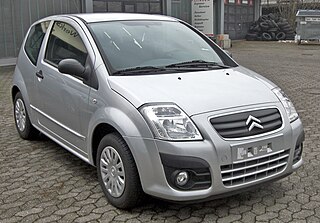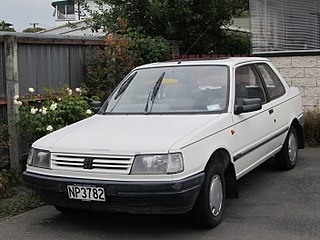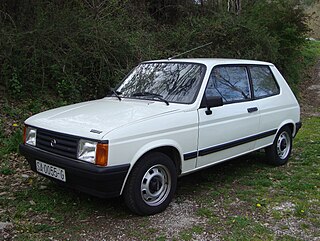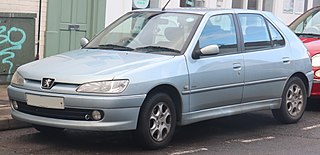
The Citroën Saxo was a supermini produced by the French manufacturer Citroën from 1996 to 2003. It was sold in Japan as the Citroën Chanson, because Honda had registered the "Saxo" name. The Saxo was a badge engineered variant of the Peugeot 106, the major difference being interiors and body panels. Production ended in 2003, when it was replaced with the Citroën C2 and Citroën C3 which launched a year earlier.

The Citroën C2 is a supermini that was produced by the French manufacturer Citroën, with production starting August 2003. It replaced the Citroën Saxo and was built at the Aulnay plant, on the outskirts of Paris. The Citroën C2 was discontinued in October 2009, and replaced by the Citroën DS3 in January 2010.

The Volkswagen Polo is a supermini car (B-segment) produced by the German car manufacturer Volkswagen since 1975. It is sold in Europe and other markets worldwide in hatchback, saloon, and estate variants throughout its production run.

The Peugeot 205 is a supermini (B-segment) car produced by the French manufacturer Peugeot from 1983 to 1999.

A hot hatch is a fast version of a hatchback car. The term originated in the mid-1980s; however, faster factory versions of hatchbacks have been produced since the 1970s. A front-mounted engine that uses petrol for fuel, together with front-wheel drive, is the most common powertrain layout, however all-wheel drive has become more commonly used since around 2010. Most hot hatches are of European or Asian origin.

The Citroën AX is a supermini which was built by the French manufacturer Citroën from 1986 to 1998. It was launched at the 1986 Paris Motor Show to replace the Citroën Visa and Citroën LNA.

The Metro is a supermini car, later a city car that was produced from 1980 to 1998, first by British Leyland (BL) and later by the Rover Group. It was launched in 1980 as the Austin Mini Metro. It was intended to complement and eventually replace the Mini, and was developed under the codename LC8. The Metro was named by What Car? magazine as "Car of The Year" in 1983 as an MG, and again as the Rover Metro in 1991.

The Citroën BX is a large family car which was produced by the French manufacturer Citroën from 1982 to 1994. In total, 2,315,739 BXs were built during its 12-year history. The hatchback was discontinued in 1993 with the arrival of the Xantia, but the estate continued for another year. The BX was designed to be lightweight, using particularly few body parts, including many made from plastics.

The Peugeot 309 is a small family car that was manufactured between 1985 and 1994 in England, Spain and France by PSA Peugeot Citroën. It was originally intended to be badged as a Talbot and, as development progressed, to be called the Talbot Arizona.

The Rover 200 Series, and later the Rover 25, are a series of small family cars that were produced by British manufacturer Rover from 1984 until 2005.

The Peugeot 206 is a supermini car (B-segment) designed and produced by the French car manufacturer Peugeot since May 1998 as a replacement to the Peugeot 205. Developed under the codename T1, it was released in September 1998 in hatchback form, which was followed by coupé cabriolet in September 2000, station wagon in September 2001, and a sedan version in September 2005, before being replaced by the 207 in April 2006.

The Talbot Samba is a city car manufactured by the PSA Group in the former Simca factory in Poissy, France, and marketed under the short-lived modern-day Talbot brand from 1981 to 1986. Based on the Peugeot 104, it and the Talbot Express were the only Talbots not inherited from Chrysler Europe, engineered by PSA alone. It was also the last new Talbot car to be launched. Its demise in 1986 was effectively the end of the Talbot brand for passenger cars. Launched initially as a three-door hatchback, it was also for some time the only small car available in a factory-ordered cabrio body style, and the most economical car in Europe.

The Peugeot 207 is a supermini car (B) that was designed and produced by the French automaker Peugeot from 2006 to 2014. It was presented at the Geneva Motor Show in 2006, and entered production in April 2006, as the successor to the Peugeot 206. It shares the same platform with the Citroën C3.

The TU family of small inline-four piston engines by PSA Peugeot Citroën were introduced in 1986 and used in the Peugeot and Citroën range of cars. It was first installed in the Citroën AX in October 1986, replacing the X family, although it shared many components with its predecessor. The TU is available in either petrol or a naturally aspirated diesel variant, the latter called TUD.

The Peugeot 308 is a small family car produced by French automobile manufacturer Peugeot. It was unveiled in June 2007, and launched in September 2007. The 308 replaced the 307, and positioned below the 508 and above the smallest 208.
1991 in motoring includes developments in the automotive industry that occurred throughout the year 1991 by various automobile manufacturers, grouped by country. The automotive industry designs, develops, manufactures, markets, and sells motor vehicles.

The Peugeot 306 is a small family car built by the French car manufacturer Peugeot from 1993 to 2002. It replaced the 309. Peugeot gave the 306 many updates and aesthetic changes to keep up with the competition, and it was replaced by the 307 in 2001. Cabriolet and estate versions continued until 2002. Versions were built in Argentina by Sevel from 1996 to 2002.

The Volkswagen Golf Mk2 is a hatchback, the second generation of the Volkswagen Golf and the successor to the Volkswagen Golf Mk1. It was Volkswagen's highest volume seller from 1983 and ended in (German) production in late 1992, to be replaced by the Volkswagen Golf Mk3. The Mk2 was larger than the Mk1; its wheelbase grew slightly, as did exterior dimensions. Weight was up accordingly by about 120 kg (260 lb). Exterior design, developed in-house by VW design director Schäfer, kept the general lines of its Giugiaro-designed predecessor, but was slightly more rounded. All told, about 6.3 million second-generation Golfs were built.

The Peugeot 208 is a supermini car produced by the French automaker Peugeot. Unveiled at the Geneva Motor Show in March 2012 and positioned below the larger 308. The 208 replaced the 207 in 2012, and the car is currently at its second generation.

Škoda Favorit is a model name that the Czechoslovak car maker Škoda Auto has used for two series of car models.


























